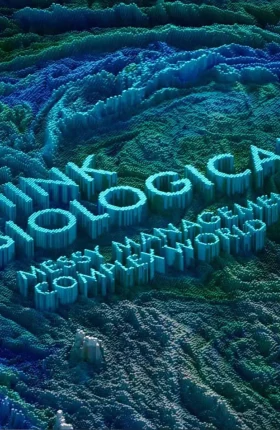Our binary political system is blowing up, argues Thomas L. Friedman, the Pulitzer Prize–winning journalist, best-selling author, and New York Times foreign affairs columnist. Just as classical computing was built on a system of zeros and ones, our traditional political system has been built on the left and the right. But in a time of upheaval from globalization, new technology, and climate change, binary politics is insufficient. We need a system that’s more adaptive, and that’s what we’re seeing in the shift to what Friedman calls quantum politics, in which people are not at either pole but multiple places at once.
Martin Reeves, BCG managing director and senior partner, and chairman of the BCG Henderson Institute, spoke with Friedman at the 2020 World Economic Forum meeting in Davos, Switzerland, about the move from the binary to the quantum—in computing and in politics—and what it takes for communities, companies, and countries to adapt and survive. Below is an edited excerpt of their conversation.
Tom, what’s your assessment of how politics works today?
I think what we have today can be best understood by watching what is disappearing. And what’s disappearing, you may have noticed, is that every major political party in the OECD has blown up in the last six or seven years. They’ve either splintered or they’ve been gutted. They’ve kept their shell, their brand name, but inside they’ve become completely different, or they’ve just disappeared. Something’s in the water… What’s going on?
I would argue that the parties we have today were all basically a response to the last great “energy release.” They were all responses to the moment when capitalism met the industrial revolution. A moment that was beautifully described by Marx and Engels, a moment when “all that was solid melted into air,” and basically “all fixed, fast-frozen relations,” as Marx and Engels said in the 1848 Communist Manifesto, became unstuck. And what politics was about for the next 100 years, basically, was how do you get the best out of that “climate change,” and how do you cushion the worst?
It took us a while to figure it out, and we went through two wars and a lot of ideas, communism, fascism, socialism, and imperialism, before we settled on the response. And the response was the welfare state. Our version of it was the New Deal, the European version of it was social democracy. The Middle East, Latin America, and Asia had their derivations of it. And what the social welfare state said was, we’re going to install these walls and these floors to get the most out of this release of energy and to cushion the worst. And what politics became about was a very binary division between how high you think the walls should be and how thick you think the floor should be. And that became known as left and right.
We ended up with a very stable binary grid that we call left and right. That was capital versus labor on how thick your floors should be and how high your walls should be. It was big government, high regulation or small government, low regulation. It was open to immigration or closed to immigration. Open to trade or closed to trade. Open to new social norms--gay marriage, transgender rights--or closed to new social norms. And in recent years, green versus growth.
And you think this dualist approach is not only breaking down, but is also inadequate for the problems that we face?
The answer is yes to both, and they’re interrelated. Because basically, in a slower world without these “climate changes,” these parties were there forever. But we had the third great release of energy and three climate changes at once. And I would argue it blew up this binary left/right political grid.
The example I like to give is, imagine that I’m a steelworker in Pittsburgh. Monday to Friday, I’m in the steel union. I’m with labor, baby. But on Saturday I drive for Uber and on Sunday I rent out my kid’s spare bedroom on Airbnb before I go shopping at Walmart for the cheapest-made Chinese goods I can find. And what I can’t get there, I get from my Amazon chatbot. On weekends, baby, I am with capital. I don’t want any regulation in my life. I want to take advantage of a completely deregulated world. Which party am I in? Monday to Friday I’m in this party; Saturday, Sunday, I’m in this other party. So what those contradictions did is they blew asunder this binary system.
I like to compare it to the transition that’s happening around computing. Because of course, classical computing, which has dominated computing for the last 70 years, was binary. It was built on zeros and ones. You had transistors that toggled back and forth between zeros and ones with an electric impulse, and that toggling produced computing and storage. I think we’re going from a binary computing world to a quantum computing world , just as we’re going from a binary politics to a quantum politics.
We’re going from a binary politics to a quantum politics.
So what’s the central thesis here in terms of where we’re going or where we should go?
Binary computing, because it was binary, based on zeros and ones, was basically like flipping a quarter. And if you could do it a billion times, you could generate a lot of compute and storage. You were either heads or tails; you were either in this state of zero or one. Or in political terms, you were either left or right. Quantum computing, of course, is not like flipping a quarter. It’s more like spinning a quarter. And you could actually be in multiple states at the same time. I could be at the poles, I could be at the equator. And it generates not bits, but qubits. These qubits can be both zero and one. They can be in multiple states, and the way you get computing in quantum is through a process called constructive interference.
What’s the political analogy for that?
The political analogy is now you move from a binary political grid politics to an ecosystem politics. In an ecosystem you’re in multiple states at the same time. There’s no binary.
You’re not talking about lots of small parties with competing policies and no power and no ability to get anything done…
No. What you’re talking about actually is a politics that’s built around what I call complex adaptive coalitions. Just as in nature, nature’s ecosystems that thrive are all built on complex adaptive networks. In the real world, quantum politics are being practiced today, in two places: in all the thriving small towns in America, and in small countries. In New Zealand, where I just came from, the government today is a coalition between a center-left party, a virulent anti-immigration party, and a green party. Austria today has a government by the center-right and the greens. Now, why are small communities the first to adopt quantum politics, moving from a grid to an ecosystem? It’s because they don’t have “oil.” One of Friedman’s first rules of politics is that wherever there’s oil, there’s trouble! Oil creates an exogenous resource that you can just extract from the ground and it allows you to resist adaptation to the climate change.
It’s a buffer. It buffers you from the need to respond. And of course, there’s a reason that the Arab world is struggling the most today with this, because they had all the oil and it buffered them from the adaptation process. Whereas China had the least, and there was no buffering and they had to adapt. So who has “oil” today? They’re called political parties. Republicans and Democrats, because of campaign contributions, can generate “oil”—synthetic oil—and that synthetic oil is enabling them to resist, up to now, the climate changes. But small communities have no oil. They can’t print money.
In biology, an adaptive system needs essentially three process steps. It needs variation—it needs to be able to generate alternatives, diversity, different policy choices. It has to have some selection mechanism to select things based on what works—not based on theory or an ideology, but based on what works in the circumstances of the time. And then it needs some amplification mechanism, some way of scaling that into the organism and the population. So this sort of more adaptive political system that you imagine, how does it do that variation, selection, and amplification?
Very good question. So let me start by picking up on your nature analogy. I depend on Mother Nature to teach me a lot, and if we’re moving to an ecosystem system, then to respond to climate changes, who knows better than Mother Nature? So I called her up, made an appointment, went out to see her. I said, “Mother Nature, you’ve dealt with more climate changes than anybody. What’s your strategy for getting resilience and propulsion when the climate changes?” She said, “Well, Tom, I have to tell you, everything I do, I do unconsciously. But these are my strategies.
“First of all, I’m incredibly adaptive. In my world, it’s not the strongest that survive. It’s not the smartest that survive. It’s the most adaptive that survive. And I produced that through a process I call natural selection. You may have heard of it.” Secondly, she said, “I am incredibly entrepreneurial. Wherever I see a blank space in nature, I basically fill it with a plant or animal perfectly adapted to that niche. I’m incredibly entrepreneurial.” That’s your generating diversity. And third, she said, “I’m incredibly pluralistic.” She said, “I am the most diverse person you’ve ever met. I try 20 different species of everything. I see who wins and who can respond best to different conditions. And I notice,” she told me, “something very interesting.” She said, “I notice that my most diverse ecosystems are also my most resilient and propulsive ecosystems. Tom, I love diversity.” Fourth, she said, “I’m a lifelong learner, and I take all my new learning and turn it into DNA to pass on to the next generation.” Fifth, she said, “I’m incredibly hybrid and heterodox in my thinking. I will try any trees with any soils, any bees with any flowers. I think you called it different policy choices. Nothing ideological or dogmatic about me.” Sixth, she said, “I’m completely open source. I let anybody fork off anywhere, see where they go.” Seventh, she said, “I notice that my healthiest ecosystems are healthy because they all network together into complex adaptive coalitions or networks, where all the parts of the system maximize their resilience and propulsion by actually networking together.” And lastly, Martin, she did say, “Tom, I do believe in the laws of bankruptcy. I kill all my failures. I return them to the great teacher in the sky, and I take their energy to nourish my successes.”
So my argument is the community, the company, and the country that most closely mirrors those strategies is the one that will actually thrive in this age of climate changes and acceleration. Now let’s go to your question. Your question was, “Well, who’s actually doing it and why?” Well, I would tell you that the cliché about America today is we’re a country divided between two coasts, two coasts that are pluralizing, diversifying, globalizing, and modernizing. And then there’s flyover America. Well, I happen to be from flyover America, a small town in Minnesota, and I can tell you that ain’t true. Okay? Actually, America today is a checkerboard of communities that are rising from the bottom up and communities that are collapsing from the top down. Some are right next door to each other.
And the ones that are rising are because of the three things you just said, or the seven things I just said, which were just variations on those themes. What do the towns that are rising have in common? They’re all actually applying quantum politics. How so? Here’s what they have in common. First of all, they’re responding to an urgent need to change. Sometimes it’s the loss of the factory, sometimes it’s zero unemployment. Secondly, all these towns have a high density of leaders without authority. These are people from within the community who step forward to get stuff done. Sometimes they’re elected, sometimes not. They’re people who just said, “My granddaddy grew up in this town, my daddy grew up here, and I’m going to stay here and we’re going to make this work. I’m not giving up.”
Third, all the leaders who have authority network together into what I call a complex adaptive coalition, where the business community partners with the philanthropic community, partners with the education community, partners with the social entrepreneur community, partners with local government, and they create a complex adaptive coalition. To what end? To respond to the climate changes, just as nature has complex adaptive ecosystems.
These coalitions have one rule, and again, it’s all your little three things. Their rule is, when we meet, you see that hook on the door, Mr. Reeves? Check your politics at that hook. Because when you come in this room, our politics is only two words: What works? My book is actually, at its core, to define quantum politics. I coined three terms. I didn’t invent these words, but I’m using them in a totally different context. My argument is what these three accelerations, these three climate changes in globalization, technology, and climate did, is they made the world fused, fast, and deep. And quantum politics is actually a response to those three phenomenon. So let’s talk about all of them.
Their rule is, when we meet, you see that hook on the door? Check your politics at that hook. Because when you come in this room, our politics is only two words: What works?
First, it made their world fuse, because suddenly we are now recognizing that climate-wise, we are fused. I was just in New Zealand. I was breathing the air of Sydney fires 2,500 miles away. Now, in the old days, if you had a bad climate and I had a good climate, I said, “Martin, too bad. Bad luck for you.” Now I know that your bad climate is in part due to policy choices you have made and that are affecting the air I breathe. We are fused now in a way we have never been before. Therefore, I’ve got to be in multiple states at the same time. I’ve got to think about you, how I relate to you in a totally different way now.
At the same time, the world’s getting fast. When the world gets this fast, my ability to keep up depends on my ability to be a lifelong learner. And what that means is education has to change and my company has got to go into the education business. Because nobody understands the new skills that are needed actually better than my company. And to wait for the education system—which is terribly plagued by “oil,” which is called university endowments—to adapt to this change, is to wait. I don’t have time for that. You know, when Google released TensorFlow, the machine learning algorithm three years ago, Udacity, the online learning platform, had a course up in 30 days on TensorFlow. Was there any university in the country that had a course up on TensorFlow in 30 days? Google just released TensorFlow 2.0. Udacity had a course up the same day. Is there any university that had a course up on TensorFlow the same day? What I’m saying is, companies now have to be in multiple states at the same time. I’m going to have to be your employer and your educator.
I’m going to add the third word: deep. So you may have noticed that we suddenly all started using the word deep. Nobody ordered it, but suddenly we all said, “Well, that’s deep fake. That’s deep state. That’s deep mind. That’s deep research. That’s deep medicine.” All of a sudden we all started reaching for a word that nobody ordered, but we all started using it. Why? Because we sensed this is about the acceleration of technology. The technology is now going to places that were so deep and dark before I could never even imagine it. I can now toggle your DNA. I can hit atoms in this material or in your body. I can fake your visage, your face, with a depth of precision now that was unimaginable five years ago.
Thanks for sharing your views, Tom. It’s been a great pleasure.
This was really great, Martin. Thank you so much.
The BCG Henderson Institute is Boston Consulting Group’s strategy think tank, dedicated to exploring and developing valuable new insights from business, technology, and science by embracing the powerful technology of ideas. The Institute engages leaders in provocative discussion and experimentation to expand the boundaries of business theory and practice and to translate innovative ideas from within and beyond business. For more ideas and inspiration from the Institute, please visit
Featured Insights
.







